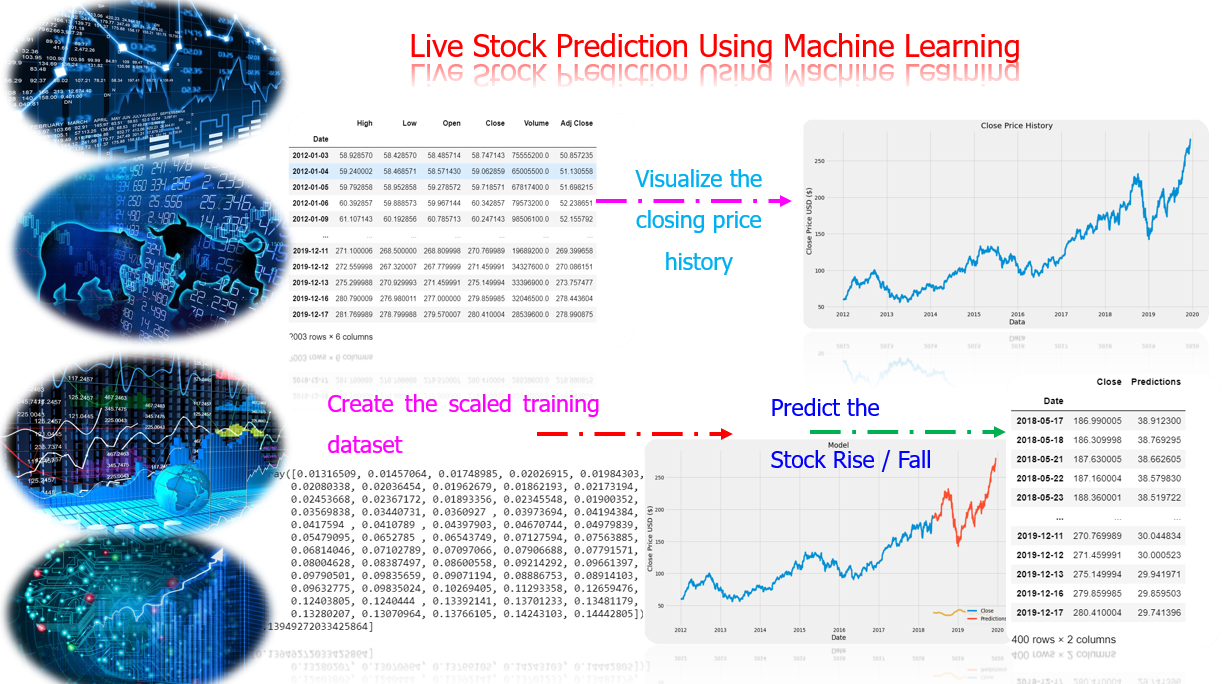projects on machine learning – Live Stock Prediction Using Machine Learning
Request for Project – [email protected] ; [email protected]
Contact Number – 7667668009 / 7667664842
For complete project lists – final year project for cse
For internship – internship in chennai
Abstract
In the finance world stock trading is one of the most important activities. Stock market prediction is an act of trying to determine the future value of a stock other financial instrument traded on a financial exchange. the prediction of a stock using Machine Learning. The technical and fundamental or the time series analysis is used by the most of the stockbrokers while making the stock predictions. The programming language is used to predict the stock market using machine learning is Python. we propose a Machine Learning (ML) approach that will be trained from the available stocks data and gain intelligence and then uses the acquired knowledge for an accurate prediction. A machine learning technique called Support Vector Machine (SVM) to predict stock prices for the large and small capitalizations and in the three different markets, employing prices with both daily and up-to-the-minute frequencies.
Introduction on – projects on machine learning
Basically, quantitative traders with a lot of money from stock markets buy stocks derivatives and equities at a cheap price and later on selling them at high price. The trend in a stock market prediction is not a new thing and yet this issue is kept being discussed by various organizations. There are two types to analyze stocks which investors perform before investing in a stock, first is the fundamental analysis, in this analysis investors look at the intrinsic value of stocks, and performance of the industry, economy, political climate etc. to decide that whether to invest or not. On the other hand, the technical analysis it is an evolution of stocks by the means of studying the statistics generated by market activity, such as past prices and volumes. In the recent years, increasing prominence of machine learning in various industries have enlightened many traders to apply machine learning techniques to the field, and some of them have produced quite promising results. Develop a financial data predictor program in which there will be a dataset storing all historical stock prices and data will be treated as training sets for the program. The main purpose of the prediction is to reduce uncertainty associated to investment decision making. Stock Market follows the random walk, which implies that the best prediction you can have about tomorrow’s value is today’s value. Indisputably, the forecasting stock indices is very difficult because of the market volatility that needs accurate forecast model. The stock market indices are highly fluctuating and it effects the investor’s belief. Stock prices are considered to be a very dynamic and susceptible to quick changes because of underlying nature of the financial domain and in part because of the mix of a known parameters (Previous day’s closing price, P/E ratio etc.) and the unknown factors (like Election Results, Rumors etc.). There has been numerous attempts to predict stock price with Machine Learning. The focus of each research projects varies a lot in three ways.
- The targeting price change can be near-term (less than a minute), short-term (tomorrow to a few days later), and a long-term (months later),
- The set of stocks can be in limited to less than 10 particular stock, to stocks in particular industry, to generally all stocks.
- The predictors used can range from a global news and economy trend, to particular characteristics of the company, to purely time series data of the stock price.
The probable stock market prediction target can be the future stock price or the volatility of the prices or market trend. In the prediction there are two types like dummy and a real time prediction which is used in stock market prediction system. In Dummy prediction they have define some set of rules and predict the future price of shares by calculating the average price. In the real time prediction compulsory used internet and saw current price of shares of the company. Computational advances have led to introduction of machine learning techniques for the predictive systems in financial markets. In this paper we are using a Machine Learning technique i.e., Support Vector Machine (SVM) in order to predict the stock market and we are using Python language for programming.
HARDWARE REQUIREMENTS
- System : Intel inside i3
- System Type : 64-bit Operating System
- Storage :500GB
- RAM :4 GB
SOFTWARE REQUIREMENTS
- Operating system : Windows 10
- Software : Anaconda , Python
- Python Libraries: Numpy, Matplotlib, Keras, Pandas.
Machine Learning – projects on machine learning
In the real world, we are surrounded by humans who can learn everything from their experiences with their learning capability, and we have computers or machines which work on our instructions. But can a machine also learn from experiences or past data like a human does? So here comes the role of Machine Learning.
Machine Learning is said as a subset of artificial intelligence that is mainly concerned with the development of algorithms which allow a computer to learn from the data and past experiences on their own. The term machine learning was first introduced by Arthur Samuel in 1959.
Machine learning enables a machine to automatically learn from data, improve performance from experiences, and predict things without being explicitly programmed.
With the help of sample historical data, which is known as training data, machine learning algorithms build a mathematical model that helps in making predictions or decisions without being explicitly programmed. Machine learning brings computer science and statistics together for creating predictive models. Machine learning constructs or uses the algorithms that learn from historical data. The more we will provide the information, the higher will be the performance.
A machine has the ability to learn if it can improve its performance by gaining more data.
How does Machine Learning work
A Machine Learning system learns from historical data, builds the prediction models, and whenever it receives new data, predicts the output for it. The accuracy of predicted output depends upon the amount of data, as the huge amount of data helps to build a better model which predicts the output more accurately.
Suppose we have a complex problem, where we need to perform some predictions, so instead of writing a code for it, we just need to feed the data to generic algorithms, and with the help of these algorithms, machine builds the logic as per the data and predict the output. Machine learning has changed our way of thinking about the problem.
Features of Machine Learning in, projects on machine learning:
- Machine learning uses data to detect various patterns in a given dataset.
- It can learn from past data and improve automatically.
- It is a data-driven technology.
- Machine learning is much similar to data mining as it also deals with the huge amount of the data.
Need for, projects in Machine Learning
The need for machine learning is increasing day by day. The reason behind the need for machine learning is that it is capable of doing tasks that are too complex for a person to implement directly. As a human, we have some limitations as we cannot access the huge amount of data manually, so for this, we need some computer systems and here comes the machine learning to make things easy for us.
We can train machine learning algorithms by providing them the huge amount of data and let them explore the data, construct the models, and predict the required output automatically. The performance of the machine learning algorithm depends on the amount of data, and it can be determined by the cost function. With the help of machine learning, we can save both time and money.
The importance of machine learning can be easily understood by its uses cases, currently, machine learning is used in self-driving cars, cyber fraud detection, face recognition, and friend suggestion by Facebook, etc. Various top companies such as Netflix and Amazon have build machine learning models that are using a vast amount of data to analyze the user interest and recommend product accordingly.
Following are some key points which show the importance of Machine Learning:
- Rapid increment in the production of data
- Solving complex problems, which are difficult for a human
- Decision making in various sector including finance
- Finding hidden patterns and extracting useful information from data.
Now, you are able to get an idea for the reason for the, projects on machine learning
Numpy
NumPy is used in projects on machine learning which stands for numeric python which is a python package for the computation and processing of the multidimensional and single dimensional array elements.
Travis Oliphant created NumPy package in 2005 by injecting the features of the ancestor module Numeric into another module Numarray.
It is an extension module of Python which is mostly written in C. It provides various functions which are capable of performing the numeric computations with a high speed.
NumPy provides various powerful data structures, implementing multi-dimensional arrays and matrices. These data structures are used for the optimal computations regarding arrays and matrices.
In this tutorial, we will go through the numeric python library NumPy in implementing, projects on machine learning
The need of NumPy
With the revolution of data science, data analysis libraries like NumPy, SciPy, Pandas, etc. have seen a lot of growth. With a much easier syntax than other programming languages, python is the first choice language for the data scientist.
NumPy provides a convenient and efficient way to handle the vast amount of data. NumPy is also very convenient with Matrix multiplication and data reshaping. NumPy is fast which makes it reasonable to work with a large set of data.
There are the following advantages of using NumPy for data analysis.
- NumPy performs array-oriented computing.
- It efficiently implements the multidimensional arrays.
- It performs scientific computations.
- It is capable of performing Fourier Transform and reshaping the data stored in multidimensional arrays.
- NumPy provides the in-built functions for linear algebra and random number generation.
Nowadays, NumPy in combination with SciPy and Matplotlib is used as the replacement to MATLAB as Python is more complete and easier programming language than MATLAB.
In case of learning these technologies, you can opt for
- Internships like machine learning internship , data science internship or python internship
- trainings can be like machine learning training in chennai , data science training in chennai or python training in chennai
- Inplant training can be machine learning inplant training , python inplant training or data science inplant training
This, projects on machine learning will have the following Modules
- Get the stock quote
- Visualize the closing price history
- Scale the data
- Create the scaled training dataset
- Visualize the data
- Show the valid and prediction
This project is provided to the students who are looking for,
- machine learning techniques for stock prediction
- stock price prediction using linear regression python
- stock market prediction using machine learning project report
- stock market prediction using machine learning research paper
- stock price prediction using machine learning ppt
- stock-price-prediction using machine learning github
- stock price prediction using machine learning colab code
- stock market prediction using machine learning project code
Sample Coding :
#import libraries
import math
import pandas_datareader as web
import numpy as np
import pandas as pd
from sklearn.preprocessing import MinMaxScaler
from keras.models import Sequential
from keras import Dropout
import matplotlib as plt
plt.style.use(‘fivethirtyeight’)
# projects on machine learning
#Create the training dataset
#Create the scaled training dataset
train_data = final_dataset[0:training_data_len , :]
valid_data = final_dataset[training_data_len:,:]
#Split the data into x_train and y_train datasets
scaler=MinMaxScaler(feature_range=(0,1))
scaled_data=scaler.fit_transform(final_dataset)
x_train,y_train = [],[]
for i in range(60, len(train_data)):
x_train.append(scaled_data[i-60:i,0])
y_train.append(scaled_data[i, 0])
if i<= 60:
print(x_train)
print(y_train)
print()
Project Output and Screenshots



